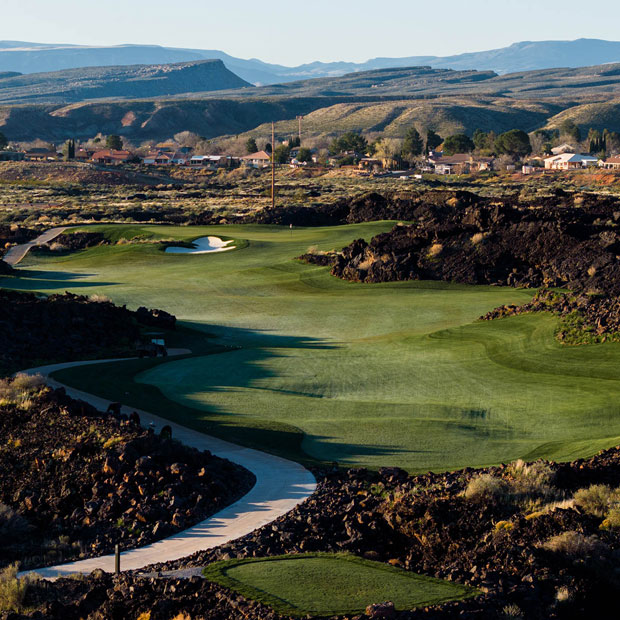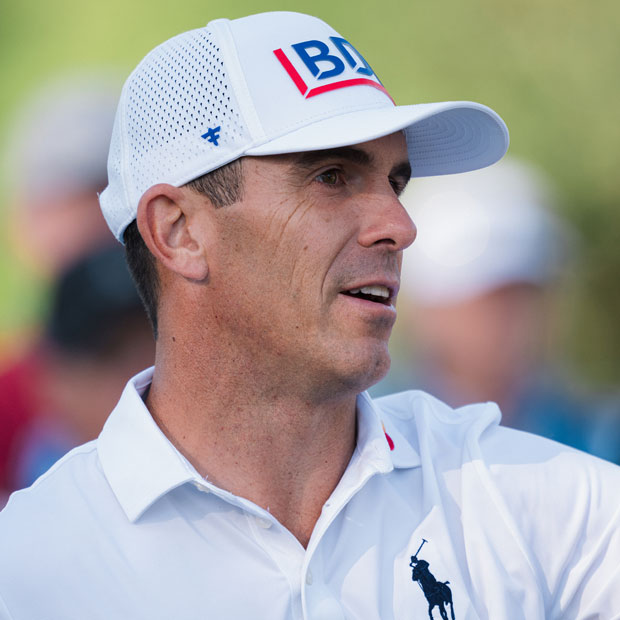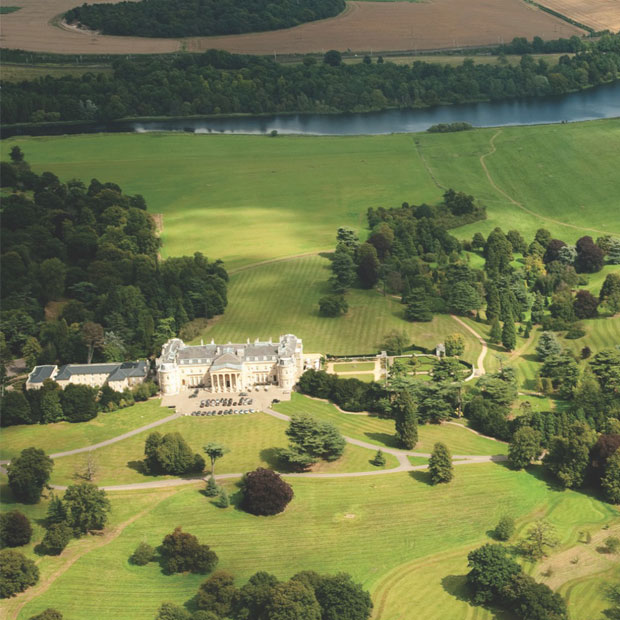Prairie Dunes Country Club
Perry and Press Maxwell's Prairie Dunes melds seamlessly with the Kansas dunescape and boasts one of the finest sets of greens in American golf

Hutchinson, Kansas, USA
Perry Maxwell (original design of initial nine, 1937), Press Maxwell (original design of second nine, 1956)
Private
Perry Maxwell's Prairie Dunes - Original 9
Prairie Dunes: Then and Now
Perry Maxwell, Prairie Dunes and Southern Hills
In 1935, Perry Maxwell met with the Carey family, owners of a local salt company, about building a course on the outskirts of Hutchinson, Kansas. Depending on which historical account you believe, either Maxwell discovered or the Careys led him to a stunning tract of Ice Age-forged duneland east of town. Beneath the wild grasses, yucca, sandhill plum, and cottonwood trees, Maxwell must have recognized the undulations, large and small, that would make for compelling golf. The next year, he set about building the first nine holes of what the Careys hoped would eventually be a 36-hole complex. The construction methods were rudimentary, relying on beasts of burden and non-mechanized equipment like scrapers and wheelbarrows. The result was a links-like course that meshed humbly yet artfully with the landscape.
Twenty years later, after both the Great Depression and World War II had passed, Maxwell’s son Press built nine more holes at Prairie Dunes—three on the west side of the property and six on a large paddock to the northeast. Press’s work matches his father’s well enough that many visitors are surprised to learn that the course was not built all at once. In recent years, the club has employed Dave Axland, former associate for Coore & Crenshaw and the co-architect of three-Egg Wild Horse, to lead various historical renovation projects. Axland’s efforts toward re-naturalizing the course’s bunkers have been particularly notable and successful.
This Club TFE course profile will look a little different from the others. Since we’ve already published a great deal of content on Prairie Dunes, we have adapted portions of that past material into this post. Also, this profile will not contain a conventional “Overall Thoughts” section but instead a hole-by-hole tour. Enjoy!
{{content-block-course-profile-prairie-dunes-country-club-001}}
Take Note…
Depression-era minimalism. Dean Woods, a civil engineer and Perry Maxwell’s brother-in-law, supervised the construction of the first nine at Prairie Dunes. Like Maxwell, Woods was opposed to the use of steam shovels and other modern contraptions. As Mal Elliott writes in his book Perry Maxwell’s Prairie Dunes, “The construction of the course was done with teams of horses and mules, 18 in all, and slips and Fresno scrapers and wheelbarrows. There was not one piece of mechanized equipment except for the Model T and Model A Fords and trucks which took the workers to the site. The greens and fairways were cleared and scraped by teams dragging plows and scoops. The roots of native grass and weeds were all removed by hand, one wheelbarrowful at a time.” This approach set Maxwell and Woods apart from many other golf architects of the period, like Langford & Moreau, who used steam shovels liberally.
What did Press know? Possibly in 1936 and certainly before he died in 1952, Perry Maxwell completed a plan for an 18-hole course at Prairie Dunes. It seems likely that Press Maxwell had a copy of this plan: according to club history, he brought it to a green committee meeting in 1954. While no one alive has seen the plan or knows where it might be, there is a strong feeling among knowledgeable club members that Press mostly followed his father’s instructions in building the new holes (Nos. 3-5 and 11-16)—with one major exception that I’ll address in the hole-by-hole tour.
Tee it forward. In order to achieve a championship yardage near 7,000 yards, Prairie Dunes has created many new back tee boxes over the past few decades. The green-to-tee walks are a lot more pleasant, however, if you play from the middle, or in some cases forward, teeing grounds. The designs of the holes tend to make more sense from those spots, too.
Influencer. When we discuss the most influential American golf courses, Prairie Dunes doesn’t usually get mentioned, but it should. There is a clear line of influence starting at Prairie Dunes and leading to Sand Hills and Bandon Dunes and… pretty much everything that has happened in golf course architecture and development in the past quarter century. Architect Ian Andrew laid out a version of this argument in a brief essay in the Golf Club Atlas discussion group back in 2009.
Unlikely as it seems, Prairie Dunes could be even better. Fairway lines on many holes can and should be pushed out to increase strategic options and highlight landforms that are currently lost in gunsch (native grasses at Prairie Dunes). However, the strengths of the land and architecture are more than sufficient for three-Egg status. Prairie Dunes is among the small handful of completely sui generis American golf courses.
3 Eggs
Unlikely as it seems, Prairie Dunes could be even better. Fairway lines on many holes can and should be pushed out to increase strategic options and highlight landforms that are currently lost in gunsch (native grasses at Prairie Dunes). However, the strengths of the land and architecture are more than sufficient for three-Egg status. Prairie Dunes is among the small handful of completely sui generis American golf courses.
Course Tour

No. 1, par 4, 452 yards
The tough opening hole swings to the left, into the prevailing wind, daring you to cut the corner to get a shorter approach. The real fun, though, starts at the green. From the 1930s to the present day, golf writers have spoken of “Maxwell rolls,” and this green is a good example of why. Here, instead of simple tiers, you see ripples that rise to a point and fall away. This style of contouring raises the stakes of the shots played into, around, and on the green: if your ball finds the correct side of a “roll,” it will collect toward the pin; if it doesn’t, it will veer away.
{{content-block-course-profile-prairie-dunes-country-club-002}}
No. 2, par 3, 164 yards
Carved into the property’s main dune ridge, the second green is an imposing target. The green points to about 10 o’clock, seeming to ask for a right-to-left shot shape, while the wind tends to push the ball to the right, toward a back bunker where, I can personally assure you, you do not want to be.
{{content-block-course-profile-prairie-dunes-country-club-003}}
No. 3, par 4, 355 yards
The first Press Maxwell hole at Prairie Dunes, the third tumbles down from a hilltop tee to a fairway that slants diagonally from right to left. The green—with its wavy, potato chip-like contouring—is a dead ringer for Press’s father’s style.
{{content-block-course-profile-prairie-dunes-country-club-004}}
According to club lore, Perry Maxwell’s original 18-hole plan called for a longer, more dramatic third hole playing back up the dune ridge to today’s fourth green. His fourth hole, then, would have been located somewhere on the back side of the ridge. This arrangement would have offered two advantages, in my view: 1) a downhill par 3, for the sake of variety (all of the course’s current par 3s play uphill); 2) an absolutely world-class third hole.
No. 4, par 3, 171 yards
The fourth green, beautifully blended into an upslope, bears some resemblance to the second but points to two o’clock rather than 10. A left-to-right shot fits the geometry here, but an unforgiving false front rejects half-hearted attempts.
{{content-block-course-profile-prairie-dunes-country-club-005}}
No. 5, par 4, 477 yards
The savagely difficult fifth hole uses a ploy found in abundance at Perry Maxwell’s Old Town Club: the fairway tilts from left to right, and the green—narrow, long, and benched sideways into the dunes—opens up only to those who manage to hold the higher left side.
{{content-block-course-profile-prairie-dunes-country-club-006}}
No. 6, par 4, 387 yards
The sixth hole brings us back to Perry Maxwell’s 1937 routing. From the original tee—today’s forward tee—this short par 4 unfurls around a big bunker on the left. Beyond this intimidating hazard, there is an area of maintained rough from which a sightline opens to the left portion of the crowned green. A fairway bunker on the right guards the other decent look at various pins. From the middle of the fairway, your view is obstructed by a flashed bunker that appears to border the green but is in fact 13 yards short.
This is one of several holes at Prairie Dunes that would benefit from fairway expansion. Pushing the mowing lines to the outer edges of both fairway bunkers would bring the best, riskiest options back into play.
{{content-block-course-profile-prairie-dunes-country-club-007}}
No. 7, par 5, 512 yards
The seventh hole is now a short par 5, but Maxwell designed it as a long par 4. Once you find the fairway, you can either lay up to a generous area short of the green-side bunkers or trust your downwind approach to hold a green surrounded by treacheries of undulation, sand, and shrubbery.
{{content-block-course-profile-prairie-dunes-country-club-008}}
Favorite Hole
No. 8, par 4, 468 yards
The best-known hole at Prairie Dunes tumbles over some of the most impressive terrain on the property—huge, lurching waves of land. The usual left-to-right wind diverts tee shots toward a stretch of gunsch where, if you find your ball, you will have no view of the green and no real hope of hitting it. Only with a powerful drive will you avoid a blind second shot. Even then, you will likely be hitting from an awkward lie to a severely canted green perched high in the sand hills. This is golf as pure adventure.

{{content-block-course-profile-prairie-dunes-country-club-009}}
No. 9, par 4, 452 yards
If the eighth hole shows off the Hutchinson dunesland at its most dramatic, the ninth emphasizes its subtler contours. A closely mown swale to the left of the green influences tactics all the way back to the tee. To be able to aim your approach away from this hollow instead of toward it, your tee shot has to ride the wind to the left side of the fairway without sailing into a large, gnarly bunker. The more you hedge away from this hazard, the worse the angle of your second shot becomes. A further complication: on the safer right side of the fairway, the undulations grow bigger, increasing the likelihood of a lie that will force your approach left, toward that green-side basin.
{{content-block-course-profile-prairie-dunes-country-club-010}}
No. 10, par 3, 190 yards
Like the seventh hole, the 10th runs with the prevailing wind and features bunkers short of the green. This tests the player’s ability to land the ball in a precise spot. When the pin is on the right, there are two options: 1) drop a downwind mid-iron just past the bunker on the right and somehow keep it from running through, or 2) go left and accept the inevitability of a triple-breaking, 60-foot lag putt.
When I think of a prototypical scalloped Maxwell green, this one comes to mind. From the devilish hummock center-right, to the merciful central channel, to the repelling edges front left and back left, every section makes for delightful chipping and putting.
{{content-block-course-profile-prairie-dunes-country-club-011}}
No. 11, par 4, 535 yards
This stern par 4, which plays to a far more reasonable 426 yards from the middle tees, kicks off a stretch of six Press Maxwell-designed holes. Challenging the large bunker embedded in a dune on the inside of the dogleg gives players a shorter approach and a better chance of flying the mischievous knob fronting the green.
Whereas the front nine has a tight, interlocking routing (as does Perry’s original nine), holes 11 through 16 describe a wide loop, with a large stretch of unused land in the middle. This provides a sense of space and adventure that distinguishes the back nine from the front—and Press’s holes from Perry’s.
{{content-block-course-profile-prairie-dunes-country-club-012}}
No. 12, par 4, 395 yards
A collection of controversial cottonwoods pinch the approach to the 12th green, harassing any second shots not played from the center third of the fairway. On the one hand, the concept does feel somewhat gimmicky, especially on a links-inspired course. On the other, the hole wouldn’t necessarily be improved by the trees’ removal. As it is, they at least pose a dilemma: the farther up the fairway you push your tee shot, the more likely you are to find yourself blocked out.
{{content-block-course-profile-prairie-dunes-country-club-013}}
No. 13, par 4, 445 yards
The 13th hole is a study in the siting of golf features. The fairway banks off of an upslope to a group of dunes on the right, curves around a pair of flashed bunkers, then straightens out as it climbs to a green nestled just below the summit of a rise. This kind of simple, natural design is much harder to replicate than it might seem.
{{content-block-course-profile-prairie-dunes-country-club-014}}
No. 14, par 4, 405 yards
My favorite of Press Maxwell’s holes, the 14th offers two distinct options from the tee: play safely to the initial section of the fairway on the right, or try to carry the inside corner of the dogleg, which is guarded by a hillock and a pair of bunkers. The green is tucked into a grove of cottonwoods, but this time the trees are part of the scenery, not the scene.
{{content-block-course-profile-prairie-dunes-country-club-015}}
No. 15, par 3, 200 yards
The least distinguished par 3 at Prairie Dunes is at least made memorable by a tee shot played through a cottonwood chute.
{{content-block-course-profile-prairie-dunes-country-club-016}}
No. 16, par 4, 426 yards
The 16th is the first par 4 on the back nine to bend right rather than left. While the green appears to be angled to receive approaches from the outside of the dogleg, a bank on the left side of the green allows players who challenge the right fairway bunker to funnel their second shots onto the putting surface.
{{content-block-course-profile-prairie-dunes-country-club-017}}
No. 17, par 5, 523 yards
Maxwell’s original 17th tee was just behind the 10th green, and the tee shot played diagonally across the dune ridge between Nos. 17 and 18. There was visible room to the left, but the prime position was to the right of the hog’s back in the fairway, blind from the tee and close to death in the prairie grass. From there, you had a chance to go for the narrow, elevated green, defended by bunkers left and a drop-off right.
In expanding the course to 18 holes, Press Maxwell moved the 17th tee to the east. Now it is a straightaway hole—still excellent, but not quite as fun.
{{content-block-course-profile-prairie-dunes-country-club-018}}
No. 18, par 4, 390 yards
While relatively short, the 18th is a culminating trial of nerve. As on No. 17, the garden spot is on the right, but a strong right-to-left slope makes it hard to hit. Also, since this section of the fairway is concealed from the tee, and since the wind presses scarily toward the dunes on the right, a bailout to the left just feels better. It results, however, in a blind approach that would have been even more uncomfortable back when the pit short of the green had sand in it.
As a finishing hole for match play, No. 18 at Prairie Dunes is ideal. It can yield birdies as readily as X’s.
{{content-block-course-profile-prairie-dunes-country-club-019}}
Want to Play Prairie Dunes?
Fried Egg Golf Events head to Hutchinson this summer for 36 holes at Prairie Dunes. Details available HERE. Registration opens to Club TFE members on Tuesday, January 28.
Additional Content
Maxwell’s Masterpiece: Prairie Dunes (Video)
Perry Maxwell, Prairie Dunes, and Southern Hills (Fried Egg Golf Podcast)
Perry’s Nine (Fried Egg Golf Article)
Prairie Dunes: Then and Now (Fried Egg Golf Article)
What to Know About Perry Maxwell (Fried Egg Golf Article)
Maxwell’s Muffins (Fried Egg Golf Article)
Leave a comment or start a discussion
Get full access to exclusive benefits from Fried Egg Golf
- Member-only content
- Community discussions forums
- Member-only experiences and early access to events

















Leave a comment or start a discussion
Lorem ipsum dolor sit amet, consectetur adipiscing elit. Suspendisse varius enim in eros elementum tristique. Duis cursus, mi quis viverra ornare, eros dolor interdum nulla, ut commodo diam libero vitae erat. Aenean faucibus nibh et justo cursus id rutrum lorem imperdiet. Nunc ut sem vitae risus tristique posuere. uis cursus, mi quis viverra ornare, eros dolor interdum nulla, ut commodo diam libero vitae erat. Aenean faucibus nibh et justo cursus id rutrum lorem imperdiet. Nunc ut sem vitae risus tristique posuere.